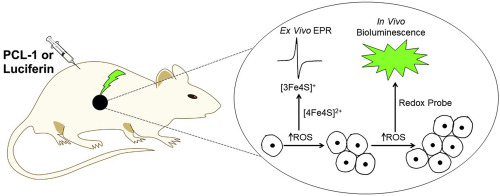当前位置:
X-MOL 学术
›
Free Radical Bio. Med.
›
论文详情
Our official English website, www.x-mol.net, welcomes your feedback! (Note: you will need to create a separate account there.)
Increased formation of reactive oxygen species during tumor growth: Ex vivo low-temperature EPR and in vivo bioluminescence analyses.
Free Radical Biology and Medicine ( IF 7.4 ) Pub Date : 2019-12-23 , DOI: 10.1016/j.freeradbiomed.2019.12.020 Gang Cheng 1 , Jing Pan 2 , Radoslaw Podsiadly 3 , Jacek Zielonka 4 , Alexander M Garces 5 , Luiz Gabriel Dias Duarte Machado 5 , Brian Bennett 5 , Donna McAllister 6 , Michael B Dwinell 7 , Ming You 8 , Balaraman Kalyanaraman 9
Free Radical Biology and Medicine ( IF 7.4 ) Pub Date : 2019-12-23 , DOI: 10.1016/j.freeradbiomed.2019.12.020 Gang Cheng 1 , Jing Pan 2 , Radoslaw Podsiadly 3 , Jacek Zielonka 4 , Alexander M Garces 5 , Luiz Gabriel Dias Duarte Machado 5 , Brian Bennett 5 , Donna McAllister 6 , Michael B Dwinell 7 , Ming You 8 , Balaraman Kalyanaraman 9
Affiliation

|
Previous studies have shown that reactive oxygen species (ROS) such as superoxide or hydrogen peroxide generated at low levels can exert a tumor-promoting role via a redox-signaling mechanism. Reports also suggest that both tumorigenesis and tumor growth are associated with enhanced ROS formation. However, whether ROS levels or ROS-derived oxidative marker levels increase during tumor growth remains unknown. In this study, in vivo bioluminescence imaging with a boronate-based pro-luciferin probe was used to assess ROS formation. Additionally, probe-free cryogenic electron paramagnetic resonance was used to quantify a characteristic aconitase [3Fe4S]+ center that arises in the tumor tissue of mouse xenografts from the reaction of the native [4Fe4S]2+ cluster with superoxide. Results indicated that tumor growth is accompanied by increased ROS formation, and revealed differences in oxidant formation in the inner and outer sections of tumor tissue, respectively, demonstrating redox heterogeneity. Studies using luciferin and pro-luciferin probes enabled the assessment of tumor size, ROS formation, and bioenergetic status (e.g., ATP) in luciferase-transfected mice tumor xenografts. Probe-free ex vivo low-temperature electron paramagnetic resonance can also be translated to clinical studies.
中文翻译:

在肿瘤生长过程中增加活性氧的形成:离体低温EPR和体内生物发光分析。
先前的研究表明,低水平产生的活性氧(ROS),例如超氧化物或过氧化氢,可以通过氧化还原信号机制发挥肿瘤促进作用。报道还表明,肿瘤发生和肿瘤生长均与ROS形成增强有关。然而,在肿瘤生长期间ROS水平或ROS衍生的氧化标志物水平是否增加仍是未知的。在这项研究中,使用基于硼酸酯的荧光素原探针进行体内生物发光成像来评估ROS的形成。此外,使用无探针的低温电子顺磁共振来定量从天然[4Fe4S] 2+团簇与超氧化物的反应而在小鼠异种移植物的肿瘤组织中出现的特征乌头酸酶[3Fe4S] +中心。结果表明,肿瘤的生长伴随着ROS形成的增加,并揭示了肿瘤组织内部和外部的氧化剂形成的差异,这表明了氧化还原异质性。使用荧光素和荧光素原探针的研究能够评估荧光素酶转染的小鼠肿瘤异种移植物中的肿瘤大小,ROS形成和生物能状态(例如ATP)。无探针的离体低温电子顺磁共振也可以转化为临床研究。
更新日期:2019-12-23
中文翻译:

在肿瘤生长过程中增加活性氧的形成:离体低温EPR和体内生物发光分析。
先前的研究表明,低水平产生的活性氧(ROS),例如超氧化物或过氧化氢,可以通过氧化还原信号机制发挥肿瘤促进作用。报道还表明,肿瘤发生和肿瘤生长均与ROS形成增强有关。然而,在肿瘤生长期间ROS水平或ROS衍生的氧化标志物水平是否增加仍是未知的。在这项研究中,使用基于硼酸酯的荧光素原探针进行体内生物发光成像来评估ROS的形成。此外,使用无探针的低温电子顺磁共振来定量从天然[4Fe4S] 2+团簇与超氧化物的反应而在小鼠异种移植物的肿瘤组织中出现的特征乌头酸酶[3Fe4S] +中心。结果表明,肿瘤的生长伴随着ROS形成的增加,并揭示了肿瘤组织内部和外部的氧化剂形成的差异,这表明了氧化还原异质性。使用荧光素和荧光素原探针的研究能够评估荧光素酶转染的小鼠肿瘤异种移植物中的肿瘤大小,ROS形成和生物能状态(例如ATP)。无探针的离体低温电子顺磁共振也可以转化为临床研究。


























 京公网安备 11010802027423号
京公网安备 11010802027423号